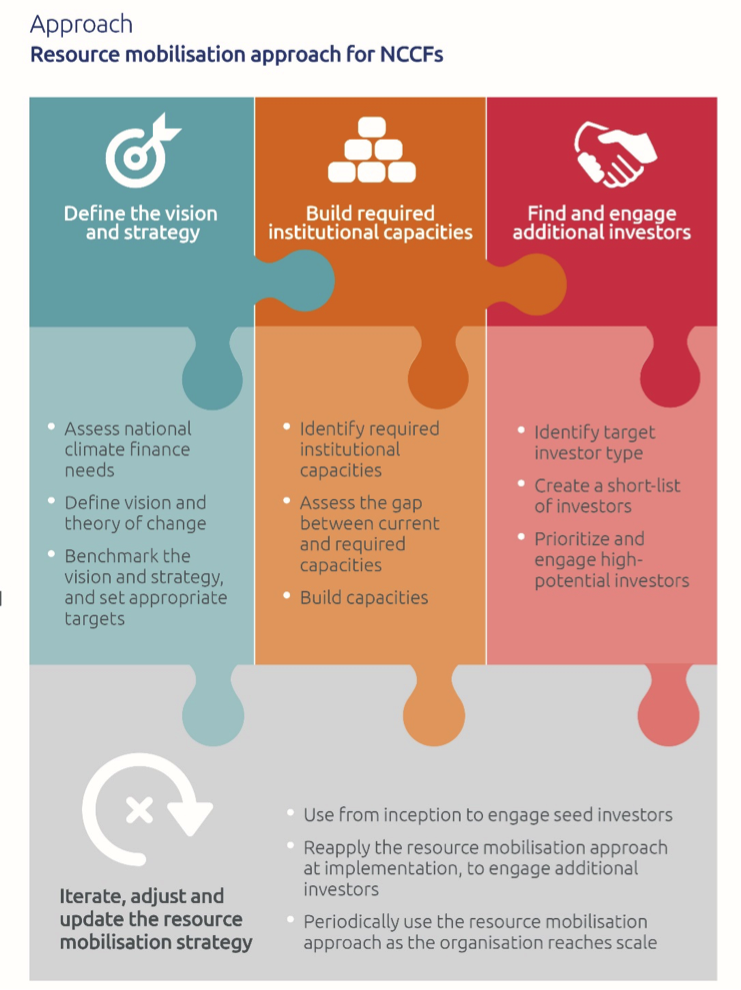How can National Climate Change Funds mobilise resources more effectively?
How can National Climate Change Funds mobilise resources more effectively?
National Climate Change Funds have experienced mixed success in mobilising climate finance. Ellie Marsh and James Eustace of Dalberg discuss a CDKN-commissioned tool that outlines a step-by-step approach to assist countries with their resource mobilisation efforts.
This handbook outlines a resource mobilisation approach that draws on the existing best practices of National Climate Change Funds (NCCFs) and other similar organisations, identified from interviews with experts and extensive desk research
National Climate Change Funds (NCCFs) are national-level entities that help countries direct climate finance towards climate change projects and programmes. NCCFs were designed for two primary reasons: to mobilise international and domestic climate finance for national climate change activities, and to strengthen government ownership of the decisions around how the money is allocated. They were intended to be the point of entry for international and national climate finance for the country.
In reality, however, NCCFs have experienced mixed success mobilising resources, and whilst some have been successful, others have faced significant challenges. They have so far not played a significant role in global climate change financing and have often been unable to mobilise sufficient resources to achieve their goals. In response to these mixed results, CDKN commissioned a study to assess the sustainability of NCCFs and explore possible approaches to resource mobilization. The output of this study was a report outlining a high-level resource mobilisation approach that can be used as a tool to structure resource mobilisation efforts. This approach can be used at all stages of the life-cycle of a fund, and aims to help increase the flow of resources to NCCFs.
The approach addresses the key barriers NCCFs have faced when mobilising resources. Based on these barriers (combined with information from interviews with NCCFs, conservation funds, NIEs, donors and technical experts) the study identified three key steps to successful resource mobilisation:
1. Define a clear vision and strategy. A clearly defined vision with a coherent supporting strategy, and specific goals that are clearly linked to activities, are the building blocks for a strong resource mobilisation strategy. The first step to defining a vision and strategy is to identify a need that must be filled in the climate finance space. Once the need is identified, the vision, mission and goals of the organisation should be defined using a theory of change. Finally, to ensure the vision and goals set are realistic, they should be assessed against the performance of other similar organisations.
- Build required institutional capacities. NCCFs must have the institutional capacities required to achieve their objectives. The capacities required extend beyond just personnel training, and comprise of four components: people and culture; tools and processes; structure and governance and; partnerships. Organisations should identify the elements of institutional capacity that are relevant for its specific activities, and compare these capacities against the existing organisation. Once the required capacities have been identified, the NCCF should create a plan for capacity building and work to achieve it, prioritising those elements that are most critical to near-term success.
- Find and engage investors. Once a NCCF has built a vision and strategy and institutional capacity plan, it is well placed to engage investors to secure a long-term flow of finance. A systematic approach to investor engagement enables organisations to focus their efforts on the highest priority investors, and also to set expectations appropriately as to likely success. To do this, organisations should identify which types of investors align with their financial and impact objectives, and create a short-list of those investors whose past and current investment activities indicate they may be interested. Organisations should then assess and prioritise these investors according to how easy it is to access funding, the likelihood of securing funding, and their relative resource potential, and begin the engagement process.
When tested with a subset of funds, feedback to the above approach was positive. Several interviewees valued the systematic approach to resource mobilisation. In particular, funds appreciated the method of prioritising potential investors and agreed it aligned with best practice.
A detailed, step-by step guide to the resource mobilisation approach can be found here:
NCCF Policy Brief CDKN & Dalberg
NCCF Resource Mobilisation Report

